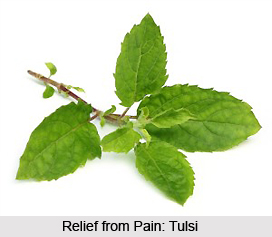 Joint pain is a very common disease in women and older generation of our society. Tulsi in Ayurved can prevent from this disease.
Joint pain is a very common disease in women and older generation of our society. Tulsi in Ayurved can prevent from this disease.
•The roots, leaves, inflorescences, twigs and seeds of a plant constitute what is collectively known as its `panchang` or its five parts. Take equal amounts of each, grind them and sieve. Ten gms of this mixture mixed with an equal amount of aged jaggery, and taken with goat`s milk every morning and evening will relieve pain in the joints.
•Repeated administration of five gms of a mixture of the juices of Shyama Tulsi, garlic and onions, and smearing the mixed juices all over the body is beneficial in tetanus as well as spasms due to other causes.
•A fine powder is prepared by grinding five gms of Shyama Tulsi leaves, three gms of meudi (sindhuar) leaves, five gms of bhangra, and three gms of the bark of varuna according to specified procedure. The powder is mixed with five gms of honey. This paste is a cure for all conditions due to excessive vata, such as pains, inflammations, etc.
•The use of a decoction of Tulsi leaves for bathing and for the fomentation of the joints is effective in the treatment of rheumatism.
•Pain in the joints can be relieved by applying a poultice of a paste of Tulsi leaves, castor leaves and saindhav (rock salt).
•Tulsi seed powder is a good remedy for muscular pain.
•Exposure to the smoke" generated by Drudrih Tulsi leaves dropped on glowing charcoal proves beneficial in all cases of abnormalities of blood due to vata, including rheumatism and oedema of the hands and feet.
•Fomentation with steam from the boiling decoction of the five parts (panchang) of the Van Tulsi plant is beneficial in all paralytic conditions such as paralysis of the torso, facial paralysis, paralysis.
Take 100 gms of each of the following ingredients, and grind them together in cow`s urine, Panchang of Tulsi, panchang of neem, panchang of kateli (a variety of the cotton plant), leaves of white sindhuar, leaves of amar vel and black makay (maize). Cook 125 gms of the paste in seasame oil over a low flame. When all the moisture is expelled, cool and strain the oil. Use this oil to massage the joints and other parts affected by rheumatism.



















